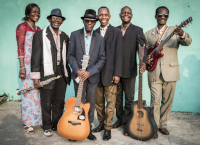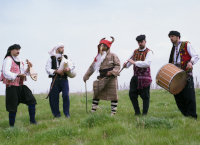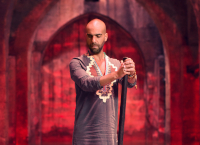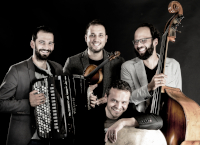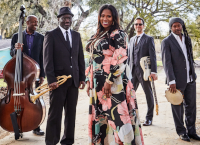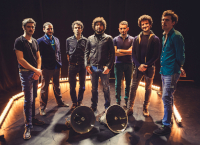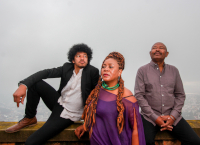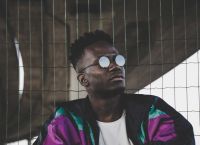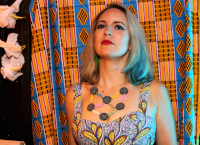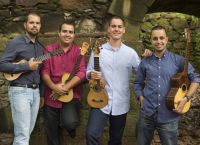- 23-27 OCT 2024
- Manchester, UK
Showcase Artists 2018
Browse through the list of the first part of the WOMEX 18 Showcase artists below and get a first glimpse of what you can expect at the Showcase Festival this year. More artists will be announced soon. A big thank you to our 7 Samurai, the independent, international jury that selected this programme.
The WOMEX 18 Showcase Festival is comprised of the Official Showcase Selection, Club Summit, Atlantic Connections and offWOMEX programmes.
Official Showcase Selection
Ariwo (Cuba/Iran/UK)
Ariwo’s music is inspired by the global sounds of London's club culture, and built with the percussive rhythms of jazz, Cuban rumba, and Persian tradition and mysticism. Ariwo is a four -piece collaboration that consists of acclaimed Iranian electronic composer, Pouya Ehsaei, percussion virtuoso Hammadi Valdes, figurehead of London's Cuban music scene, Oreste Noda, and an award-winning saxophonist, Binker Golding.
Bakolo Music International (DR Congo)
Formed by the late rumba maestro Wendo Kolosoy, BMI is the longest-serving rumba group to be based in DRC’s capital Kinshasa. They play a classic old-style Congolese rumba, with lyrics in Lingala, French, and Bantu languages. These pioneers of the 1950’s are returning to the stage, celebrating the 70th year of the group.
Edina Szirtes Mókus Looper Project (Hungary)
Edina has been composing classical music since she was seven years old. Her prolific violin playing, singing and her diverse musical background has driven her artistic involvements as a soloist, as well as with many renowned acts such as the Modern Art Orchestra, Miklós Lukács and Frank London. Her latest project combines looping with a return to her musical roots.
Etenesh Wassie Trio (Ethiopia/France)
From rhythm to melancholy, from traditional energy to sacred songs, from unrequited love to battlefields, the Etenesh Wassie Trio evokes a wide range of emotions with their vocals-led, bass-driven renditions of deep Ethiopian songs. The trio consists of Etenesh Wassie on vocals, Mathieu Sourisseau on acoustic bass and Sebastien Bacquias on double bass.
Evritiki Zygia (Greece)
Based in Evros, the northern and eastern part of Greece, Evritiki Zygia is a traditional music band active since 2007. The band’s sonic identity is their unique mix of psychedelic dance fusion, using musical instruments that are deeply rooted in the tradition of the Thracian locals - the bagpipe, the lyra, the kaval, the davul.
Frente Cumbiero (Colombia)
Masterminded by Colombian songwriter and producer Mario Galeano Toro (also founding a member of Ondatrópica and Los Pirañas), the group has been active for over a decade. Their musical influences are deeply rooted in the sounds of traditional cumbia but only to shape their contemporary signature sound.
Gulaza (Israel)
Spearheaded by outstanding singer Igal Gulaza Mizrahi, the quartet brings forth women secret songs of Yemenite society with instinctive and mystical texts that have been preserved for generations and passed from word of mouth, from mother to daughter. With their combination of traditional percussion, cello, and acoustic guitars - and the fact that these songs are sung for the first time by a man – the band creates a unique experience.
Invisible World (Czech Republic/Turkey/Serbia)
A sophisticated blend of new and old world influences, including Turkish violin, Balkan accordion and a pinch of tango nuevo, Tomáš Liška´s “Invisible World“ ventures into contemporary Czech music with skilled improvisation and ensemble playing. Their musical compositions combine elements of jazz, chamber music and the sounds of the Mediterranean and South-Eastern regions of Europe.
Kel Assouf (Niger/Tunisia/Belgium)
Based in Brussels, Kel Assouf – which means both “nostalgia” and “son of eternity” in Tamashek, the language of the Sahara nomads –have built their identity around two central ideas: the promotion of Tuareg culture, and the fight against discrimination. Lead by the exiled musician from the Sahara and former Tinariwen member, Anana Harouna, the band’s sound is a fine mix of stoner rock, fused with with electronic music, pop and desert blues.
Kim So Ra (South Korea)
An active performer of janggu (a slim waist drum used in traditional Korean music) and ambassador of Honam Province Jeongeup folk music, Kim So Ra is trained under the direct apprenticeship of human cultural asset Master Jihwa Yu. Kim is also a founding member of Korean Percussion Duo ‘BUD’ and Electronic music band ‘nuMori’ in Seoul, South Korea.
Ladama (Venezuela/Brazil/USA/Colombia)
A group of four women, virtuosic musicians, and educators - Lara Klaus, Daniela Serna, Mafer Bandola and Sara Lucas - each from a different country and culture of the Americas join forces to bring their distinct style, rhythm, and traditional roots in their compositions mixed with pop often sung in Spanish, Portuguese and English.
Liniker e os Caramelows (Brazil)
From a city known for its spectacular sunsets, Araraquara, in Sáo Paulo, comes the award winning Liniker e os Caramelows, an eight-piece band that is blending a distinctive mix of soul, R&B, with the tropical heritage of MPB, and afrobeat. Their biggest hit “Zero”, from the band’s debut album “Cru” released in 2015 – today is about to surpass 18 million views on YouTube.
Lucibela (Cabo Verde/Portugal)
The new voice from Cabo Verde, Lucibela, was born in São Nicolau, one of the Barlavento islands, north of the Sahel archipelago, and is currently living in Lisbon. In her recent debut album, “Laco Umbilical” - the cord that links the singer to her land, she explores the issues involved with being a woman and a Cabo-Verdean, living far away and loving with sensuality and grace.
Manolito Simonet y su Trabuco (Cuba)
15 albums strong, this 16-piece orchestra Manolito y su Trabuco is one of Cuba's most popular, influential and loved timba bands with dozens of international tours over the past 25 years. The group lead by Manuel Simonet, a composer, arranger and virtuoso pianist, is based on the traditional charanga setup characterised by the violin and flute, to which Manolito added drums, horns, keyboards to create his signature sound.
Marinah (Spain)
Originally known as Marina Abad, she was a singer of critically acclaimed and commercially popular Catalan band, Ojos de Brujo, the combo that broke musical boundaries merging rumba and flamenco. Pursuing a solo career since 2013, she continues her musical adventures with rumba, reggae, flamenco, Latin music, hip-hop, and Afro and Cuban styles.
Moonlight Benjamin (Haiti/France)
The powerful and original fusion between the Caribbean voodoo melodies and rhythms, led by Matthis Pascaud’s blues-rock and psychedelic style guitars, groovy basslines with tight drums and percussions, along with Moonlight's powerful and rebellious voice, this is the voodoo trance in a new, explosive style.
'Ndiaz (France)
'Ndiaz take their name from An diaz, the Breton word for 'foundation', and put Brittany’s traditional circle-dancing at its core. The band craftily weaves these dynamic roots with eastern melodies from Youn Kamm on the trumpet, Brazilian forro from Yann Le Corre on accordion, Indian rhythms from Jerome Kerihuel on percussion and the insistent resonance of Timothee Le Bour’s saxophone . New Breton dance party!
Norayr Kartashyan & Menua (Armenia)
Norayr Kartashyan, one of Armenia's finest woodwind masters and composers, created Menua in 2015. The ensemble comprises a woodwind quartet and a percussionist, playing both Armenian instruments and new hybrid instruments which have been designed over the years by Kartashyan himself. The quintet plays Armenian traditional music and original compositions with expressive arrangements for woodwind instruments such as duduk, blul, shvi, parkapzuk (bagpipe), and zurna.
Odpoczno (Poland)
The Odpoczno quartet represents artists from one region (Opoczno) but from different musical worlds: from traditional music (Joanna Gancarczyk, Marcin Lorenc), through jazz, improvised music (Marek Kądziela) to the rock alternative (Piotr Gwadera). The band’s sound is deeply rooted in traditional Polish folk music along with a steady mix of improvised alternative rock, hip-hop, and jazz influences.
Ranky Tanky (USA)
From the South Carolina Lowcountry, comes Ranky Tanky, a quintet with music rooted in an African culture that has shaped American art, food, language, and attitude. That culture, its people, and their mother tongue are called Gullah. With their jazz-influenced arrangements, Ranky Tanky revives timeless Gullah songs, stories, and music for a new generation of listeners.
Rob Thorne Toi Puoro (New Zealand)
New Zealand Māori composer, performer, and anthropologist Rob Thorne is a diverse and original explorer in the journey of Taonga Puoro (traditional Māori instruments), fusing ancient voices with modern sounds. Using looping technology, Māori flutes and horns made from stone, bone, shell, and wood, Rob creates transcendental aural experiences.
San Salvador (France)
Six voices, two drums, twelve hands and a tambourine is all that San Salvador contains. And this gives their sound: a radical polyphonic music that combines the energy and raw poetry of popular music from Occitania with fine orchestration and soft, hypnotic vocals, hyper-rhythms and sporadic panting.
Sofiane Saidi & Mazalda (Algeria/France)
A new electro-Maghreb vision by Sofiane Saidi, with the vivid and colorful sounds of Mazalda - this a feverish dive into the raï of the eighties, with dramatic synthesizers and infectious grooves, topped with eastern rhythms and melodies of psychedelic energy.
Ta Dhom Project – Viveick Rajagopalan (India)
Trained under the Carnatic tradition on percussive instruments such as mridangam and kanjira, Viveick uses his classical roots to compose music that moves between many styles, from roots to rap. The journey of Ta Dhom Project began when Viveick started teaching young rappers from Mumbai a unique art form called Konnakol that entails performing percussion syllables vocally.
The Garifuna Collective (Belize)
Hailing from Belize, Guatemala, and Honduras, The Garifuna Collective consists of the best musicians from the Garifuna music scene including Desiree Diego, Sofia Blango, and Chela Torres - leading the group. They bring together the deep cultural roots of Garifuna music, mixed with modern grooves, arrangements, and instruments. Unique hand drums, the primera and segunda, turtle shells and jawbones, guitars and bass.
Toko Telo (Madagascar)
Madagascar's supergroup interprets traditional musical styles – tsapiky, jihe, beko – with unequaled artistry. Featuring the highly acclaimed D’Gary on guitar & voice, award-winning Monika Njava on voice & percussion, and the most celebrated guitarist of his generation, Joël Rabesolo, on guitar & voice.
Vishtèn (Canada)
Hailing from Canada's Prince-Edward Island and Magdalen Island, Vishtèn has been recognized as an ambassador of Francophone culture around the world. Their music is a fiery blend of traditional French songs and original instrumentals that fuse Celtic and Acadian genres with a modern rock sensibility and indie-folk influences.
Club Summit
Buruntuma (Guinea-Bissau/Portugal)
Buruntuma is not just the name of a small village in Guinea-Bissau, in fact it is also the name of a DJ who is currently causing a stir in the Portuguese Afrohouse scene. Traditional music from his native Guinea-Bissau is one of his central elements. Buruntuma has long since arrived in the Portuguese diaspora, but now he also wants to accommodate the music of his West African homeland on the global dancefloors.
Emily Dust (UK)
An accomplished DJ and radio broadcaster who has lit up the airwaves of BBC Radio 1Xtra, Australia's Triple J, the British Council's Selector among others, Emily is firmly rooted in the UK's underground scene. Her music blends together forward-thinking club sounds like dancehall, baile, bass, kuduro, grime, and gqom.
Mawimbi (France)
Paris-based DJ crew and record label, Mawimbi has been spreading its multicultural idea of club culture from France's most famous clubs and across Europe for the past five years. Taking their inspiration from Mother Africa, Mawimbi DJs jump between genres and eras in a rather unconventional way, blending ghetto house, modern highlife and shamanic techno.
Montparnasse Musique (South Africa/Algeria/France)
Montparnasse is the story of two young producers met in Montparnasse train station in Paris. Chobolo from South Africa met Nadjib from France playing piano usually found in the big main train stations in France. Several months later they won the Lottery with 4 numbers win, then they decided to invest all the money into a journey into sound, that's when the duo was born. Their sound can be categorized as an explosive mixture of Afro Sounds and electronic that packs powerful, foot-stomping rhythm and groove. The duo is currently working on their first EP which will feature different musicians across the globe. They made their debut performance in May 2018 during Biennale in Dakar.
Uji (Argentina)
Uji (aka Luis Maurette) is a nomadic electronic producer and multi-instrumentalist born in Buenos Aires and raised throughout Latin America. His music merges the seemingly opposite worlds of the ancient and the modern in a ritual of chants and dance, drawing on Latin American, African, and various other indigenous folk traditions from around the world.
Wael Alkak (Syria/France)
A Syrian musician based in Paris, multi-instrumentalist and electronic music composer, Wael Alkak draws his repertoire from the folklore of the Levant (Chaâbi). His live performances mix tradition and modernity, where synthesizer sounds and traditional melodies produce a transcendent style, inviting bodies to let go.
Atlantic Connections
Harouna Samake ‘Kamale Blues’ (Mali)
Harouna Samake’s music is contemporary Malian blues-rock. He is the kamale ngoni player for Salif Keita, was a part of Les Ambassadeurs and has played on more than 50 albums of different artists. Backed on this project by some of Salif Keita’s musicians, there is Madou Sanogo on percussions, Legre Thibaut on drums, and Harouna’s wife Assetou Diakite on vocals.
Hernán Reinaudo Quartet (Argentina)
Hernán Reinaudo is one of the most outstanding guitarists of a new generation of tango musicians that has emerged over the last years in Argentina. Without losing the roots of popular music, the quartet seeks new forms of expression incorporating elements of jazz and contemporary music.
Júlio Pereira (Portugal)
A musician, composer, multi-instrumentalist and producer from Portugal, Júlio’s music is characterised by the use of traditional Portuguese instruments such as the cavaquinho. Although he started his career as a rock musician in groups like Petrus Castrus Xarhanga, he later began to devote himself to traditional Portuguese music.
Olga Cerpa & Mestisay (Spain)
Extremely popular in her native land, Las Palmas de Gran Canaria, Olga is considered to be one of the most important female voices of Canarian popular music from the last two decades. Performing and releasing music since 1986 she has been involved with Mestisay, utilising her solo voice as the lead singer.
Sumrrá (Spain)
Sumrrá from Galicia pays tribute to six powerful women that were, and still are an inspiration in fighting for a brighter future for all of humanity. Frida Kahlo and Rosa Parks from the US, Rosalía de Castro from Galicia, Quin Jin from China, Malala Yousafzai from Pakistan and Nawal El Saadawi from Egypt. Sumrrá 6 Mulleres is a 21st century contemporary musical approach to feminism in a jazz outfit.
Timples y Otras Pequeñas Guitarras del Mundo (Spain)
Here is music made from the Canary Islands for the rest of the world. Hailing from across the Canarian Islands are Germán López, Althay Páez, Jonathan Campos, Leandro Ojeda and Beselch and Yone Rodriguez, a bunch of outstanding timple interpreters of the new generation.
offWOMEX
Helsinki-Cotonou Ensemble (Benin/Tanzania/Finland)
Finnish guitarist Janne Halonen, Beninois singer/percussionist Noël Saïzonou and the excellent ensemble continue their imaginative and wholly uplifting mix of Afro-beat and Afro-jazz, combined with soulful songwriting and super-tight funk-fusion improvisation.


